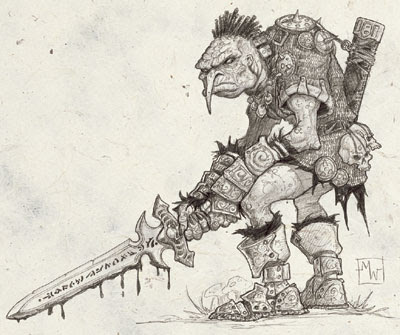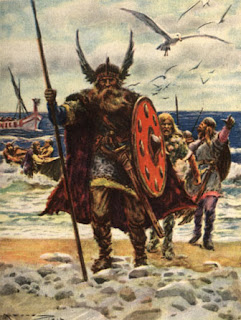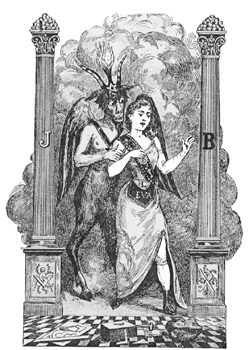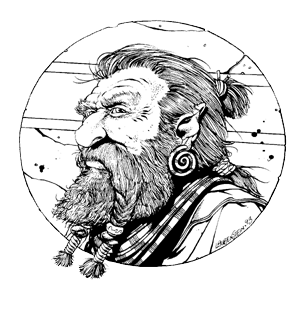Yesterday I decided to make a set of, more or less, custom mechanics that will suit me best. However, I think I will need to give myself more time before I can post anything else on the topic, as I want my mechanics to be well thought out and coherent.
That is why I will start creating the game setting first. Hopefully the process of gradually building up ideas and putting them in order will also influence writing mechanics, clearing some controversies and making it fit the setting.
As I've stated before, my biggest influence now is the OD&D and it's roots in pulp fantasy fiction. I've also decided to take the approach of just outlining my world's realia and overall atmosphere without filling out many details beforehand. This seems to be the method that fits me best, since it enables me to give my players the feeling that I want our game to have, without over intellectualizing it or creating artificial political and cultural constructs that my players may never encounter.
Don't get me wrong, I like making stuff up, I just think that letting things develop organically is much more effective and in the end will make the setting feel more real (whatever that means).

Below are the basic assumptions for My World, (I'm not so good with names, any help would be greatly appreciated), please note that they might be subject to later change.
In no particular order:
1. Magic exists, however there is no division between arcane and divine magic. I see it as a flowing, chaotic undercurrent (dynamic, prime substance) on which the material world (static) is founded. This assumption leads us to the conclusion that clerics and wizards in fact don't use two different kinds of magic, but apply two distinct ways of shaping it.
I think that my wizards will be kind of a blend between Howardian evil sorcerers and
pre-socratic philosophers. In the social context, magic will be a power feared by common folk, often associated with evil practices and so on. There will be at least one state, where wizardry is banned.
Even though I want it to have quite a dark feel, I'd also like it to be rather widespread, as I don't want to deprive PCs of magic objects. That is why I came with the story presented in 2.
2. I want my game to take place in a dark and dangerous world that has it's best days behind it. I'm thinking of a transition period, where everything is seemingly cool, yet everyone knows that life is harder, people less trustworthy and the time of great empires and truly great deeds is gone.
I've also thought that I want my world to have some old ruins that will be cursed but filled with magic items and treasures that everyone is afraid to steal, being a great theme for adventures.
That is how I arrived at the idea of a great Empire that fell under it's own hubris and gluttony. They will be an equivalent of Roman Empire or the Ottoman Empire in my world. I'll also make it highly magical, thus giving the explanation why magic is quite popular yet feared (they won't be well remembered). I think that magic will also be the reason for the Empire's end, I have some magical über catastrophe or curse, wiping their power away, though I have no idea what it could be.
Also, I'm not too keen on the Vance'ian feeling of "Holy shit, the sun might die any minute now". Think more early medieval times, maybe 8th century Europe.
3. I quite dislike the idea of gods walking the earth in rpgs, but on the other hand, I'm not a fan of settings completely devoid of deities (they can sometimes prove conceptually
interesting).
I also dislike the way many game designers treat gods, as if they are a mere addition (a good example would be 3e and 4e players handbooks), thus closing them in simple categories like god of war or goddess of love.
I think, that looking at the history of western culture (and in fact history of our world overall) religion took a very important place in shaping cultural behaviors and the way people thought for centuries. Thus I decided to create my own pantheon, that I hope will be more complicated than being a simple collection of Odin and Thor rip offs.
4. The last factor, is the presence or lack of demi-humans and in fact most fantastic races.
In the early moments of outlining my ideas in my head, I seriously considered dropping all demi-human races, but than I read
this. That made me realize, that in fact, I would be needlessly limiting my players. So what I really need to do is to reinvent the classical tolkienish races.
My first thought was to place elves as the race that built the Evil empire (however I discovered that someone had already
done that and now i feel stupid), that would give me a good excuse to place elves in seclusion in the woods, give them an inbuilt guilt and back to the roots profile, as well as limit their population in the world.
I also thought that because of the fall of their Empire and the magical curse/cataclysm, the elves had become not only mortal, but burdened with the problem of aging in a horrifying manner (altho their life spans would still be much longer than human).
The other problem are the dwarfs, since from my experience players tend to view them through one archetype (which is sad, but difficult to change). I've found
J. Maliszewski's take on dwarfs very nice, but I'd feel super bad about copying that (since I already feel a bit guilty about the elves).
As to Halflings or Gnomes, I have no ideas yet. I thought about dumping them in favor of a race of frog-men which I came up with some time ago, but I'm not sure if it wouldn't be better to use them as an addition...
Anyway. Those are my basic ideas for the game world. In posts to come, I plan on discussing them in more detail.
_______________________________
art by Frank Frazetta
 addressed to the same average viewer as Attack of the Clones. A movie with a budget of 237 million $ has to make at least twice as much in order to satisfy people who invested in it and that means it can't feature any controversial ideas, or even hint anything that might be thought as offensive, inappropriate or otherwise unsuitable for anyone who's 12 (interestingly enough, it can feature people shooting each other in the faces).
addressed to the same average viewer as Attack of the Clones. A movie with a budget of 237 million $ has to make at least twice as much in order to satisfy people who invested in it and that means it can't feature any controversial ideas, or even hint anything that might be thought as offensive, inappropriate or otherwise unsuitable for anyone who's 12 (interestingly enough, it can feature people shooting each other in the faces).
















